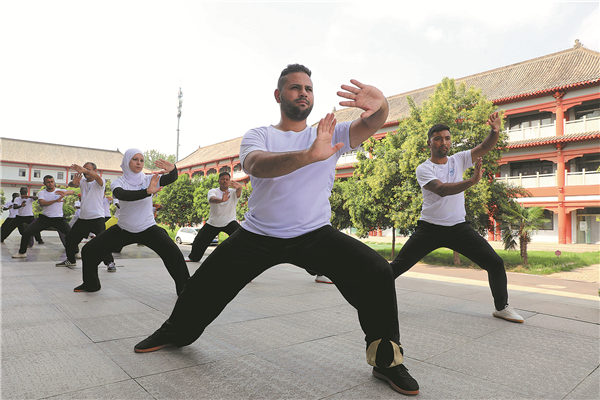

Tai chi, according to a recent study, is better than aerobic exercise for lowering blood pressure.
That's good reason to rejoice, and not just for those dealing with hypertension. After all, it shows that science is confirming the benefits long ascribed to this treasured Chinese art.
Researchers are also likely to note, as veteran practitioners like myself have found, that the body's ability to regulate its systems and to adjust and adapt to myriad challenges is enhanced through the regular practice of tai chi.

Specifically, based on my own direct observations, tai chi improves physical coordination and balance; fortifies the immune system; strengthens the body's muscles and joints via a constant emphasis on big and small rotations of the torso, waist, limbs and joints; taps into the "body brain" (which includes, but goes far beyond, muscle memory); and improves breathing, circulation and mental acuity.
Tai chi can be practiced anywhere, anytime, alone and without equipment. During the periods of pandemic isolation, this proved to be a huge advantage.
What's more, each of the various styles of tai chi imparts its own distinctive benefits in addition to those common to all tai chi (also called taiji or taijiquan).
That's why the 42 Combined Taijiquan competition routine, whose movements are culled from the four major styles of tai chi — Chen, Yang, Wu and Sun — is particularly appealing.
I had the good fortune to learn this splendid routine nearly 25 years ago from a dedicated student of Beijing's renowned Professor Li Deyin, who choreographed the 42-movement routine for introduction at the 1990 Asian Games.
I begin my daily training with the first section of the 42-movement routine, because that section's emphasis on Yang style tai chi's gentle and "soft" movements and calming rhythm allows one to take an inventory, while moving slowly, of the body's current strengths and weaknesses, and to detect any sore spots or injuries. This serves as a perfect warm-up exercise before moving on to more robust training.
What makes tai chi so rewarding is that it simultaneously does its magic at many levels.
As Chen Xin wrote in 1932 in The Illustrated Canon of Chen Family Taijiquan, "The secret of Taijiquan … lies in the fact that its movements exist not of themselves, but are elements in an ancient tapestry of thought and consciousness, combining philosophy, healing and fighting into a single fabric".
Any style of tai chi is a good choice, but you can optimize the experience by reflecting on your nature and what you hope to achieve.
For example, Chen style tai chi, the original style, is the most comprehensive regarding martial, health and mental/spiritual aspects, and it features fast and slow movements, as well as explosive bursts of power described as "fire touching gunpowder".
The Yang style is remarkable for its emphasis on softness and elasticity, so it's a good fit for "gentle souls" who are less interested in martial features.
The Wu style has a distinctive compactness and a power-building tendency to lean into a technique, and it includes balance-challenging postures done while standing on one leg.
Finally, the Sun style features higher stances that allow older people to practice it, a stepping method that enhances agility and balance, and constant repetition of a deep-breathing technique that improves lung function.
It's best to find a teacher who has a solid traditional background. Make sure you choose an instructor who is demanding yet patient, and who spends time correcting your postures and movements.
This is important because, as with baking, tai chi is an exacting art. When making a cake or cookies, you can't afford to stray from the recipe in the amount of sugar or salt or butter or baking powder, or the temperature of the oven, because even small deviations can be ruinous. Likewise, tai chi's benefits are in direct proportion to the devotee's adherence to important physical principles. So find a teacher who knows the details as well as the big picture.
It's heartening to see that science increasingly recognizes, as through the blood pressure study, that in order to fight disease or ward off the ill effects of aging, you needn't look any further than tai chi.